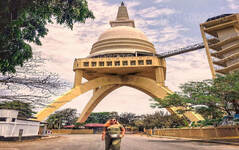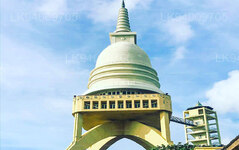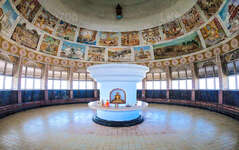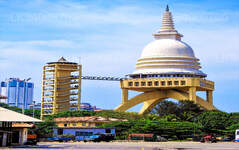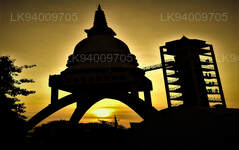
مدينة كولومبو
كولومبو، عاصمة سريلانكا، مدينة نابضة بالحياة تمزج بين الأصالة والمعاصرة. تتميز بعمارتها التي تعود إلى الحقبة الاستعمارية، وأسواقها النابضة بالحياة، ومعابدها البوذية الهادئة. بفضل مأكولاتها المتنوعة، وأفقها العمراني المتنامي، وشواطئها الخلابة، تُعدّ كولومبو مركزًا حيويًا للأعمال والثقافة والسياحة، وتُتيح بوابةً لاستكشاف عجائب سريلانكا.
Sambodhi Chaithya
Sri Lanka is a very religious place with a large number of temples, mainly Buddhist and Hindu ones. While some of them are relatively new and mundane, others have an interesting history or story to tell. Colombo, in particular, has an almost even spread of historic religious sites representing all the religions within the island; Buddhism, Hinduism, Christianity and Islam.
Sambodhi Chaithya is a Buddhist Temple with a very unique and interesting architecture. Located within the harbor of Colombo, it stands on a two diagonally intersecting concrete arches that are 11 stories (33m) tall.
The History
The entire structure was designed in 1956 by a highly reputed local engineer, A.N.S. Kulasinghe. The entire project was initiated as part of the commemoration of 2,500 years since the creation of Buddhism reckoned after the Parinirvana (Passing Away) of Gautama Buddha. Named Sri Sambuddha Jayanthi Chaithya after the event’s name, the temple was designed to be viewable by incoming ships, even during storms and bad weather.
The Architecture
The white stupa is bell-shaped, as opposed to the more commonly used dome-shape in modern Sri Lankan architecture, and placed on a square one-story platform balanced on the center of the arches and supported by four struts. The stupa alone is 47m (154 feet) tall, including the conical spire and jeweled pinnacle on top.
A stupa is called a chaithya when it’s built combined with a preaching hall; in other words if it’s a place where Buddhism is taught to many students. In the case of Sambodhi Chaithya, the hall lies beneath stupa – within the one story platform. This platform has four rooms, all representing a single-roomed solitary spiritual cultivation abode usually located in forests, but here it has been customized to a port-city setting for those who wish to still the mind.
Visiting the Chaithya
The Chaithya is located at the end of the road that runs past the Colombo Lighthouse. You will find this fantastic piece of architecture surrounded by grassy spaces, shady trees, and pools of water with picturesque little arched bridges crossing them. The premises are open from early in the morning till 6:00 pm, and entrance is free.
The stupa is reached by climbing up several flights of stairs in a vertical tower alongside. There are a total of 258 steps – a height of 11 floors, all of which have to be climbed barefoot in respect to the temple. You will have to take off your footwear at the base of the tower. The concrete stairway can get burning hot when the sun get high, so you may find it easier to do the climb early in the morning or towards the evening when the heat is lower.
At the top, you will be afforded awe-striking views of the surrounding landscape and the sea. So keep your cameras ready. The access to the stupa is through a heavy steel bridge, crossing the empty space between the staircase tower and Sambodhi Chaithya. The railings are high and very secure so that even the smallest children are safe.
Once you reach the chaithya, you will find yourself passing through heavy wooden doors into the meditation/ preaching hall. From there a staircase will lead up to the main temple. The inner part of the bell-like structure is designed and painted in such a way, that it gives the illusion of being in the endless heavens. The completely while inner walls; the bluish painted on glow emanating from the little flat circle that forms roof of the upside down bell like inner structure; the four devas (heavenly residents in Buddhist culture), on plinths along the walls at cardinal points, with their hands pressed together in worship; all add to this effect. At the middle of it all is the cylindrical shrine with four golden Buddha statues that form the centerpiece.
The upper walls of the inner temple are painted with beautifully detailed scenes from the life of Gautama Buddha and regarding the creation of Sambodhi Chaithya. The art style and color schemes of these murals are faintly Asiatic and do not resemble the usual Sri Lankan traditional boldly colored Buddhist artwork that graces the walls of many temples. These murals were hand painted in November 1986 by the famous local artist and artisan Ven. Mapalagama Vipulasara Maha Thera, who is well known in international circles for his Buddhist artwork and sculptures.
Below the murals are decorative windows looking onto the landscape and the sea, while bas-relief panels regarding Buddhism decorate the lower end of the walls below the windows. The entire effect is that of an attractive art museum more than a traditional temple, and goes towards showing the changes in culture and tradition that Buddhism and Sri Lanka as a whole are undergoing.
After viewing the stupa, and climbing down the multitude of stairs; you can roam around the grounds and see the Bo Tree planted by Lady Srimavo Bandaranaike, along with a number of old anchors, canons, massive chains from ships dating back to the Dutch era, and a vintage steam crane. The Chaithya is also close to the Sri Lanka Ports Authority Maritime Museum, which is housed in a former Dutch prison built in 1676.
With so much to see, a visit to the chaithya is definitely a fun thing to do in Colombo.
نبذة عن منطقة كولومبو
كولومبو هي أكبر مدينة وعاصمتها التجارية في سريلانكا. تقع على الساحل الغربي للجزيرة، بجوار سري جايواردينبورا كوتي، عاصمة سريلانكا. كولومبو مدينة نابضة بالحياة، تجمع بين الحياة العصرية والمباني والآثار الاستعمارية، ويبلغ عدد سكانها 647,100 نسمة. يُقدر عدد سكان منطقة كولومبو الحضرية، التي تضم مقاطعات كولومبو وغامباها وكالوتارا، بنحو 5,648,000 نسمة، وتغطي مساحة قدرها 3,694.20 كيلومترًا مربعًا. كولومبو مدينة متعددة الأعراق والثقافات، وهي المدينة الأكثر اكتظاظًا بالسكان في سريلانكا، حيث يعيش 642,163 نسمة داخل حدودها. يتكون سكان كولومبو من مزيج من مجموعات عرقية عديدة، معظمها من السنهاليين والموريين والتاميل. تقطن المدينة أيضًا جاليات صغيرة من أصول صينية وبرتغالية وهولندية وماليزية وهندية، بالإضافة إلى عدد كبير من المغتربين الأوروبيين. وتتخذ الغالبية العظمى من الشركات السريلانكية من كولومبو مقرًا لها. وتشمل بعض الصناعات الكيماويات والمنسوجات والزجاج والإسمنت والمنتجات الجلدية والأثاث والمجوهرات. ويقع في مركز المدينة ثاني أطول مبنى في جنوب آسيا، وهو مركز التجارة العالمي.
نبذة عن منطقة كولومبو
المقاطعة الغربية هي المقاطعة الأكثر كثافة سكانية في سريلانكا. تضم العاصمة التشريعية سري جاياواردنابورا كوتي، بالإضافة إلى كولومبو، المركز الإداري والتجاري للبلاد. تنقسم المقاطعة الغربية إلى ثلاث مقاطعات رئيسية هي كولومبو (642 كيلومترًا مربعًا)، وغامباها (1,386.6 كيلومترًا مربعًا)، وكالوتارا (1,606 كيلومترات مربعة). وباعتبارها المركز الاقتصادي لسريلانكا، تتواجد جميع الشركات المحلية والدولية الكبرى في المدينة، وكذلك جميع المصممين الرئيسيين وتجار التجزئة في الشوارع الرئيسية، لذا استعدوا لتجربة تسوق ممتعة في المقاطعة الغربية. ونظرًا لارتفاع عدد سكانها بين جميع المقاطعات، فإن معظم المؤسسات التعليمية الرائدة في الجزيرة تقع في المقاطعة الغربية. تشمل الجامعات في المقاطعة جامعة كولومبو، وجامعة سري جايواردينبورا، وجامعة كيلانيا، والجامعة المفتوحة في سريلانكا، والجامعة البوذية والبالية في سريلانكا، وجامعة الدفاع العامة السير جون كوتيلاوالا، وجامعة موراتوا. تحتوي المقاطعة الغربية على أكبر عدد من المدارس في البلاد، والتي تشمل المدارس الوطنية والإقليمية والخاصة والدولية.

